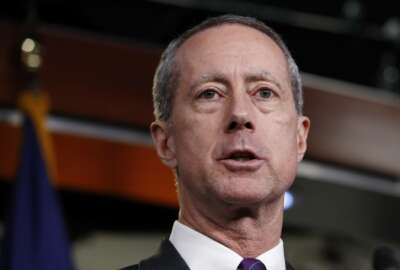Best listening experience is on Chrome, Firefox or Safari. Subscribe to Federal Drive’s daily audio interviews on Apple Podcasts or PodcastOne.
As cyber issues dominate the Defense Department’s field of vision for the future, lawmakers are considering consolidating more responsibility into U.S. Cyber Command as it is elevated into the upper echelons of the military organization.
The entity in charge of protecting the Pentagon’s cyber networks may end up fully under the jurisdiction of CYBERCOM. The suggestion from House Armed Services Emerging Threats and Capabilities Subcommittee continues the larger committee’s pattern of wresting power from the Defense Information Systems Agency.
The subcommittee’s recommendation to move Joint Force Headquarters DoD Information Networks to CYBERCOM is in line with House Armed Service Committee’s Chairman Mac Thornberry’s (R-Texas) legislation to entrench the new combatant command as the military’s one-stop shop for all things cyber.
Thornberry’s provisions in the House 2019 National Defense Authorization Act completely eliminate DISA by 2021 and move its responsibilities to CYBERCOM.
“This is designed to simplify [Joint Force Headquarters DoD Information Networks’] command and control structure and the operational control as that joint force headquarters exists — the elevation of CYBERCOM and as they’ve matured in their ability to conduct cyber defensive operations,” a committee aide said.
The aide added that DISA’s control over the headquarters is a legacy and now that CYBERCOM has matured it has the capacity to take responsibility for it.
Both DISA and CYBERCOM currently operate the headquarters.
Thornberry’s legislation not only axes DISA, but six other agencies within DoD. His plan gives the DoD chief management officer until 2020 to come up with a plan to cut the agencies.
Cyber syncing
Outside of changing the organization of DoD’s cyber network guardian, the subcommittee recommended a handful of provisions to secure networks that protect the United States’ infrastructure.
The panel suggested creating a pilot program to enhance cybersecurity cooperation between DoD and the Homeland Security Department for the nation’s most important assets.
“This is to improve coordination for response to critical infrastructure and also to enhance a common operating picture,” the aide said.
Another pilot would enlist the Defense Digital Service to identify new, innovative ways to evaluate DoD’s critical infrastructure. The provision is based off of the success of the “Hack the Pentagon” program, which challenged white hat hackers to infiltrate parts of the department’s networks to expose vulnerabilities.
The subcommittee also wants DoD and DHS to study the possibility of cyber civil support teams at the state level. The teams would be part of the reserves and operate under the command of each state’s governor.
On the science and technology front, the subcommittee is putting greater emphasis on artificial intelligence and machine learning, two areas that DoD is growing rapidly.
The subcommittee suggested creating an artificial intelligence and machine learning policy and oversight council to continuously improve research, innovation and policy that will help develop and acquire new technologies in those realms.
The subcommittee also asked DoD to review the advances in AI related to machine learning for military applications and to submit that review to Congress.
Copyright
© 2024 Federal News Network. All rights reserved. This website is not intended for users located within the European Economic Area.

